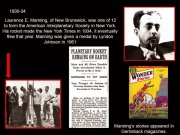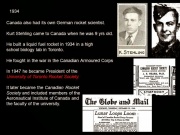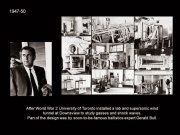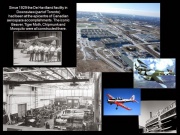100 Years of Aerospace History in Canada: From McCurdy to Hadfield Part 2 by Robert Godwin
From The Space Library
Lawrence Manning, Kurt Stehling and the Growing Interest in Space
Laurence E. Manning was born in New Brunswick and had served in World War I as a second lieutenant in the Canadian Air Force. In the late 1920s he grew interested in science fiction and began a part-time career as a writer of short stories. His fiction appeared in Wonder Stories, one of the all-science fiction magazines published in New York by Hugo Gernsback.[i] On April 4th 1930 Manning was invited to the first meeting of what would become the American Interplanetary Society; a fore-runner of today's American Institute of Aeronautics and Astronautics and the spawning ground for one of America's preeminent rocket manufacturers, Reaction Motors Inc.
Also on hand, for that evening of discussion on West 22nd street in New York, were Charles P. Mason, Adolph L. Fierst, Nathan Schachner, Warren Fitzgerald, Fletcher Pratt, William Lemkin, David Lasser, Charles W. van Devander, and the hosts for the evening G. Edward Pendray and his wife Lee Gregory Pendray.[ii] Almost all of this small group would write science fiction for Gernsback, but they would soon turn their hands to more practical work; the construction of liquid fueled rockets.
In April 1933 Manning became President of the AIS and was involved in the implementation of regenerative cooling on their early engines. A month into his presidency he constructed their launching stand at his house and acquired a launch site on Staten Island for the group to use.[iii]
He also presided the following spring when the AIS changed its name to the American Rocket Society (ARS).[iv] All through 1934 he was part of a committee which included John Shesta, Carl Ahrens and Alfred Best for Experimental Rocket #4 which subsequently became the first "really successful launch" of a liquid fuelled rocket by the ARS.[v] Manning was later given a medal by U.S.Vice President Lyndon Johnson and made an honorary lifetime member of the AIAA.
The same year that Lawrence Manning and the ARS flew the ER#4, a fifteen-year old high school student in Toronto arrived at the Toronto Central Technical High School where he would build a methane and oxygen liquid-fuelled rocket in the biology lab. His name was Kurt Richard Stehling. When he was nine-years old his family had moved to Canada from Germany, just days before the great stock market crash of 1929.[vi]
He had spent much of his spare time reading those same Gernsback science fiction magazines to which Manning had contributed. His first experiment in the rocketry field seems to have been a qualified success when the rocket successfully launched out of the classroom window. However, the wind had blown the window shut just before ignition and the young man was disciplined for his unauthorized experiment. His Rocket and Space Study Club came to an abrupt end.[vii]
When war broke out in 1939 Stehling returned to Europe in uniform to fight as part of the Canadian Armoured Corps. He witnessed the onslaught of the V2 rockets as they fell on London and he was later injured in Holland.
In the post-war period global aviation research was focused on the next great obstacle, supersonic and by extension, hypersonic flight. The University of Toronto, where Stehling returned to study, was working with money from the Canadian government to install a supersonic wind-tunnel at a Department of Defense facility in Downsview, a suburb of North Toronto, in close proximity to the DeHavilland plant.[viii] This wind tunnel was seen to be the next logical requirement for many of Canada's experiments in gasses, plasmas and shock waves. Part of this facility was built by two young student geniuses named Gerald Bull and Irving Glass.[ix]
The University of Toronto was the first of many institutes and industry partners who would benefit from government largesse. They would conduct ongoing studies in communications; atmospheric research (aurorae, plasmas, hypersonic reentry, meteoroids, cosmic rays, fluid flows, aerodynamics etc); weapons systems; optical and infra-red tracking; electronics; mining and resources; remote sensing; instrumentation; tracking stations; ground stations and sounding rockets.
Whereas the USA and Soviet Union's space programs had been initially funded predominantly for military reasons, Canada's military agenda was quickly superseded by the very real commercial prospects of better communications for the general public in remote communities.
Dozens of universities and corporations would soon get involved in studying the upper atmosphere and most specifically how the Earth's interaction with the Sun and other cosmic radiation sources affected short-wave communications. Canada's unique position of high latitude, as well as being located beneath the shortest route for Soviet missiles to reach the United States (and vice versa), created a political environment where money began to flow into Canada from institutions and governments from around the world; principally for research into the upper atmosphere.
The United States would show a particular and understandable interest in how the atmosphere above the arctic affected both communications and the stability and reliability of anything moving at high velocities in the ionosphere and mesosphere.
While government involvement in this research inevitably centered on Ottawa, several hubs of institutional and industrial activity were established, most notably in Toronto, at the University of Toronto, DeHavilland aircraft, A.V. Roe and York University; in Montreal at McGill University and RCA Canada; and at the Universities of Saskatchewan and of Western Ontario.
In later years British Columbia would also supply substantial industrial and academic contributions to Canada's space program.
Footnotes
[i] Inventor of the all-science-fiction magazine and sometime contributor to the Globe and Mail.
[ii] Prelude to the Space Age, Frank H. Winter, Smithsonian Institution Press, 1983
[iii] Astronautics May 1933
[iv] Ibid March 1934
[v] Asbury Park Sunday Press Oct 22 1961
[vi] Ancestry.com
[vii] Clarence Larson interview with Kurt Stehling. http://www.ieeeghn.org/wiki/index.php/Kurt_Stehling.
[viii] Pathway to Excellence, Gordon N. Patterson, University of Toronto, 1977
[ix] Ibid.




